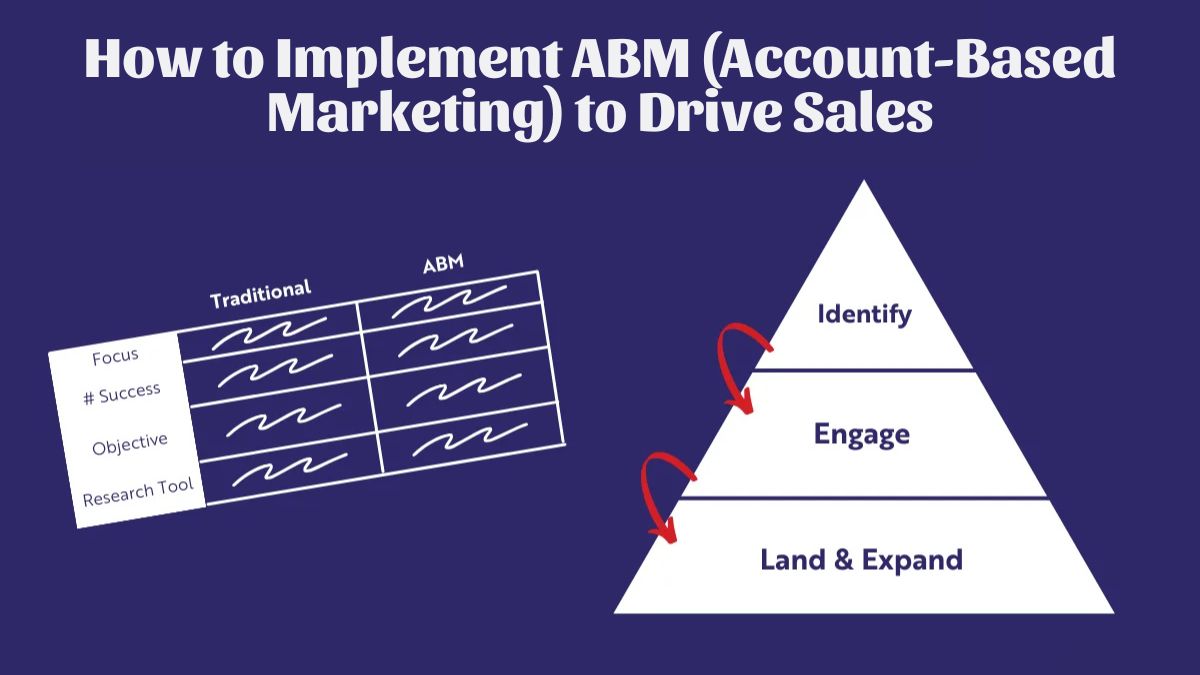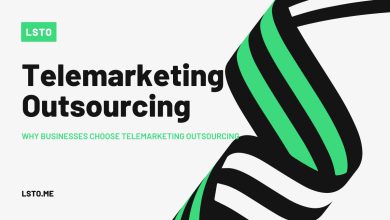
Account-Based Marketing (ABM) is a strong strategy for B2B firms. It targets high-value accounts to boost sales. Unlike traditional marketing, which casts a wide net to find leads, ABM targets specific, high-value accounts. It delivers tailored messages and strategies to each one. This approach boosts conversion rates and customer satisfaction. It does so by providing a highly personalized experience.
In this guide, we’ll explore what ABM is, its advantages, and a step-by-step approach to implementing an ABM strategy to maximize sales.
What is Account-Based Marketing (ABM)?
Account-Based Marketing is a strategy. A marketing team works with sales to identify key accounts (companies or organizations). They create customized campaigns to engage each account individually. This strategy focuses on quality over quantity, making it ideal for businesses with a smaller number of high-value clients.
ABM combines marketing and sales efforts. It gives each targeted account a unique, relevant experience. This often leads to stronger relationships, faster sales, and better ROI.
Benefits of ABM for Sales
Higher ROI: ABM strategies are designed to yield high returns by focusing on accounts with the highest potential for revenue generation.
Improved Customer Retention: By creating personalized experiences, ABM builds stronger relationships with accounts, leading to increased loyalty and retention.
Shorter Sales Cycles: ABM strategies align marketing and sales efforts from the start, reducing the time it takes to close deals.
Enhanced Alignment Between Sales and Marketing: ABM requires close collaboration between sales and marketing teams, which improves communication and operational efficiency.
Step-by-Step Guide to Implementing an ABM Strategy
Step 1: Define Your Ideal Customer Profile (ICP) and Target Accounts
Before starting any ABM initiative, it’s crucial to clearly define your Ideal Customer Profile (ICP). Your ICP outlines the characteristics of accounts that are most valuable to your business. To create an effective ICP, consider:
Company Size: Focus on company size in terms of employees and revenue.
Industry: Identify industries that are the best fit for your products or services.
Location: Target regions where your products have the most traction.
Pain Points and Goals: Determine what problems your ideal customers are trying to solve and how your solution meets those needs.
Once you’ve defined your ICP, use it to create a list of target accounts. Choose accounts that align with your business’s goals. They should be the highest value opportunities.
Step 2: Research and Gather Insights on Target Accounts
Once you have a list of target accounts, start by gathering in-depth insights about each one. This research phase helps you learn each account’s needs, preferences, and pain points. It lets you create a customized approach for each one.
Company Insights: Research the company’s business model, revenue, customer base, and any recent news or events that could impact its priorities.
Decision-Maker Information: Identify key decision-makers and influencers within each account. LinkedIn is a great resource for this.
Pain Points and Goals: Understand the challenges each account faces and what they hope to achieve.
Current Solutions: Check if they are using a competitor’s solution or your services and analyze any potential gaps or needs.
By gathering this data, you can tailor your messaging to resonate with the account’s specific needs and goals.
Step 3: Develop a Personalized Marketing Plan for Each Account
ABM is centered around personalization, so it’s important to design a tailored marketing plan for each account. Here’s how to approach this:
Segment Accounts by Industry or Priority: Group accounts that share similar needs or challenges. This allows you to create targeted messaging at scale while keeping it relevant.
Create Tailored Content: Develop content such as blog posts, case studies, or videos that address the specific needs and pain points of each account.
Choose Appropriate Channels: Determine which channels are most effective for each account. Email, LinkedIn, direct mail, and events are commonly used for ABM.
Map Out Touchpoints: Design a multi-channel engagement strategy that outlines the order of touchpoints across emails, social media, events, and direct outreach.
Personalization can be as detailed as sending custom messages to individual decision-makers. Or, it can be as broad as creating industry-specific content for similar accounts.
Step 4: Align Marketing and Sales for Collaborative Efforts
ABM relies heavily on the alignment between marketing and sales teams. To drive a successful ABM campaign, both teams need to work closely to ensure a seamless customer journey.
Set Common Goals: Define shared goals and KPIs, such as account engagement, pipeline growth, and revenue. This fosters accountability and cooperation between teams.
Regular Communication: Hold regular meetings between sales and marketing teams to discuss account insights, progress, and updates on active campaigns.
Sales Enablement: Equip the sales team with relevant content, data, and insights about each account. This includes case studies, product demos, and email templates.
By working together, marketing and sales teams can create a unified strategy. It will boost the chances of engaging and converting accounts.
Step 5: Leverage Data and Technology for Better Execution
ABM requires managing data and coordinating efforts across accounts. This can be tough without the right technology. Using ABM tools and platforms can help streamline your campaigns and ensure they’re data-driven and scalable.
Customer Relationship Management (CRM): Platforms like Salesforce can help track interactions, manage accounts, and maintain up-to-date account data.
Marketing Automation Tools: Platforms like HubSpot and Marketo enable you to automate personalized email sequences, track campaign performance, and manage leads.
ABM Platforms: Specialized ABM tools like Demandbase, 6sense, and Terminus offer account-level data, intent tracking, and engagement analytics, making it easier to execute and monitor campaigns.
Technology will let you personalize and automate outreach. It will track engagement across multiple touchpoints. Investing in ABM technology enhances both efficiency and the ability to scale your ABM efforts.
Step 6: Execute Campaigns and Engage Target Accounts
Now, launch and manage your ABM campaigns. You’ve identified your target accounts, completed your research, and planned your campaigns. Here’s how to go about it:
Outreach and Engagement: Begin by reaching out to key decision-makers. Tailor messaging based on the insights gathered for each account.
Multi-Channel Approach: Use a variety of channels—such as email, LinkedIn, direct mail, and webinars—to engage accounts on multiple fronts.
Personalized Content and Offers: Engage accounts with tailored content that speaks directly to their needs. Use relevant case studies, success stories, and special offers to demonstrate the value of your solution.
The goal is to send consistent, personalized messages. This will boost engagement and build rapport. Regular follow-ups and engagement across channels help keep interest in each target account.
Step 7: Measure, Optimize, and Scale Your ABM Campaigns
You must monitor your ABM campaigns. It is key to know which accounts are engaging and what changes are needed to improve results. Key performance metrics to track include:
Engagement Rates: Track how often accounts open emails, visit landing pages, or attend events.
Conversion Rates: Measure how many engaged accounts move forward in the sales funnel, indicating interest and intent.
Account-Level Revenue Impact: Calculate the revenue generated from each account to measure the direct impact of your ABM efforts.
Customer Lifetime Value (CLV): Track CLV to measure long-term value generated by each account.
Use these metrics to refine your strategy. Adjust it with data. Scale successful tactics to reach more high-value accounts.
Best Practices for Effective ABM
Invest in High-Quality Data: Accurate and comprehensive data is key to personalizing outreach and targeting the right accounts.
Maintain Consistent Messaging: Ensure your messaging is consistent across channels to avoid confusion and create a cohesive experience.
Experiment and Iterate: Regularly test new approaches and refine campaigns based on data and feedback to maximize results.
Prioritize Relationship-Building: Focus on building strong, meaningful relationships with each account, which can lead to long-term partnerships.
Conclusion
An Account-Based Marketing strategy can greatly improve sales. It does this by targeting the accounts most likely to generate revenue. ABM builds stronger relationships with high-value clients. It also shortens the sales cycle. It does this by using personalized outreach and aligning marketing and sales efforts. A good ABM strategy boosts conversion rates. It also builds loyalty and drives growth.
With the right data, tools, and a plan, ABM can transform B2B sales. It can boost growth for firms that use it.




